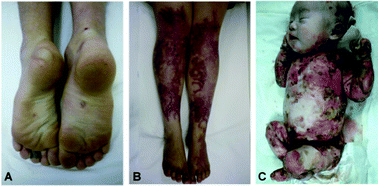In silico analysis of all point mutations on the 2B domain of K5/K14 causing epidermolysis bullosa simplex: a genotype–phenotype correlation†
Abstract
Epidermolysis bullosa simplex (EBS) is a genodermatosis caused by mutations in keratins 5 and 14 (K5 and K14), which leads to fragility of basal keratinocytes and eventually epidermal cytolysis and blistering. Depending upon the severity of symptoms, EBS is classified into three major subtypes. In order of increasing severity these classes are EBS, localized (EBS-loc), EBS, other generalized (EBS, gen-nonDM), and EBS, Dowling-Meara (EBS-DM). We have searched and assembled 36 previously reported point mutations located on the 2B domain of K5/K14 in order to investigate the effects of point mutations. By performing a comprehensive in silico analysis we determine the underlying relationship between the mutation and its phenotypic effects. Our result showed that all pathogenic point mutations exert their dominant negative effect on the K5/K14 coiled-coil heterodimer complex by altering interchain interaction, leading to the changes in stability and assembly competence of the heterodimer complex. The physico-chemical properties of substituted amino acid and location of the mutation are also deeply correlated with disease severity. In addition, we found a SNP previously reported as non-pathogenic (K14 p.M338R) that likely affects the stability of the dimer structure due to the loss of interchain interaction and steric clashes. Overall, our finding demonstrates the significance of in silico characterization of EBS severity and would allow for accurate genetic counseling and prenatal diagnosis.


 Please wait while we load your content...
Please wait while we load your content...